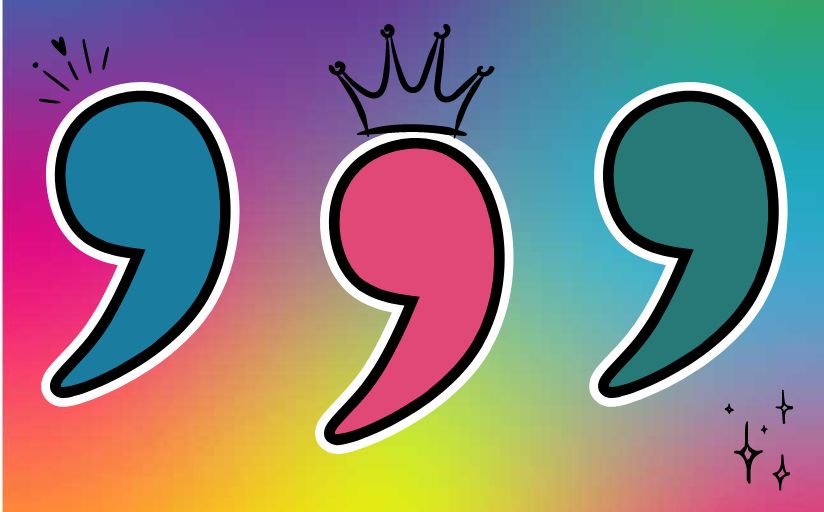Commas might seem like small, unimportant marks, but they actually hold a lot of power in writing. They can change the pace of a sentence, make the meaning clearer, and even alter the message entirely.
However, with great power comes great responsibility. Misusing commas can lead to confusion, misunderstandings, or just a cluttered piece of writing. So, how do I know if I need a comma? Here are some guidelines to help you navigate the main rules of comma usage.
1. To Separate Items in a List
One of the most common uses of a comma is to separate items in a series or list. When listing three or more items, you should use commas to separate them for clarity and readability.
This final comma in a list (known as the Oxford comma) is optional but recommended, especially in complex lists.
Examples:
- I need to buy eggs, milk, and bread.
- She packed her bags, grabbed her keys, and left the house.
- The conference will cover topics such as artificial intelligence, climate change, global health initiatives, and sustainable development.

2. To Join Independent Clauses
When you have two independent clauses (complete sentences that could stand alone) connected by a coordinating conjunction (for, and, nor, but, or, yet, so), place a comma before the conjunction.
Examples:
- I wanted to take Rover out for a walk, but he hates the rain.
- Cynthia planned to visit her friend, yet an urgent call from work kept her busy.
- Mom and Dad wanted to go hiking, so they checked the trail conditions before setting out.
3. To Set Off Introductory Elements
If your sentence begins with an introductory word or phrase, it’s often a good idea to follow it with a comma. The introductory word or phrase can include adverbs, transitional phrases, or subordinate clauses.
Examples:
- Suddenly, the sky darkened.
- On the other hand, we could try a different approach.
- Although it was late, they decided to watch another movie.
4. To Separate Coordinate Adjectives
When you have two or more adjectives that each describe a noun on their own, you should use a comma between them. But if the adjectives don’t independently describe the noun, don’t use a comma. A simple way to test this is to see if you can insert “and” between the adjectives or change their order without changing the meaning.
Examples:
- She wore a bright, colorful dress to the party.
- You can say “bright and colorful dress” or “colorful, bright dress,” so a comma is needed.
- It was a long, exhausting trip across the country.
- You can say “long and exhausting trip” or “exhausting, long trip,” so a comma is needed.
Let’s test this with one that won’t work so you can see the difference:
- They enjoyed a delicious chocolate cake.
- You wouldn’t say “delicious and chocolate cake” or “chocolate, delicious cake,” so no comma is needed.
5. To Set Off Nonrestrictive Clauses
A nonrestrictive (or nonessential) clause adds extra information to a sentence but isn’t necessary to understand its basic meaning. These clauses should be set off with commas. (Fun fact: Another name for this is the comma sandwich.)
Examples:
- My car, which I bought last year, has already needed several repairs.
- The book, with its torn cover, still remains one of my favorites.
- Her brother, who lives in New York, is coming to visit us next week.

6. Before Direct Quotes
When introducing a quote, use a comma to separate the quote from the introductory phrase.
Examples:
- Mark Twain once said, “The secret of getting ahead is getting started.”
- According to Albert Einstein, “Imagination is more important than knowledge.”
- As Steve Jobs famously noted, “Innovation distinguishes between a leader and a follower.”
7. In Dates, Addresses, and Titles
Commas are used to separate elements in dates, addresses, and titles.
Examples:
- Date: “July 4, 1776, is a significant day in American history.”
- Address: “She lives at 123 Maple Street, Springfield, Illinois.”
- Title: “Judy Blume, Ph.D., will be joining our team.”
Mastering When To Use a Comma
To recap, how do I know if I need a comma? When you’re not sure, think about what that part of the sentence is doing. Is it listing, connecting, introducing, separating, or clarifying something? Figuring this out can often help you decide if a comma is needed. And if you’re still stuck, try reading the sentence aloud. Sometimes, hearing it can help you figure out where a natural pause—and a comma—should go.
To learn more about commas, read our Complete Guide to Comma Rules so you can become a comma pro!


Leave a Reply